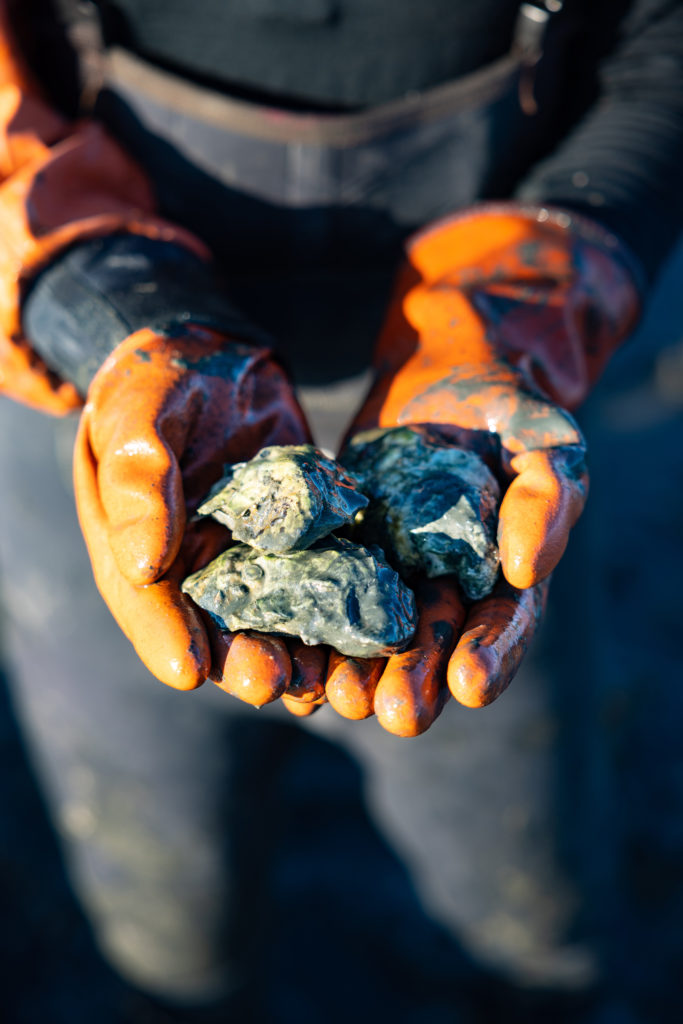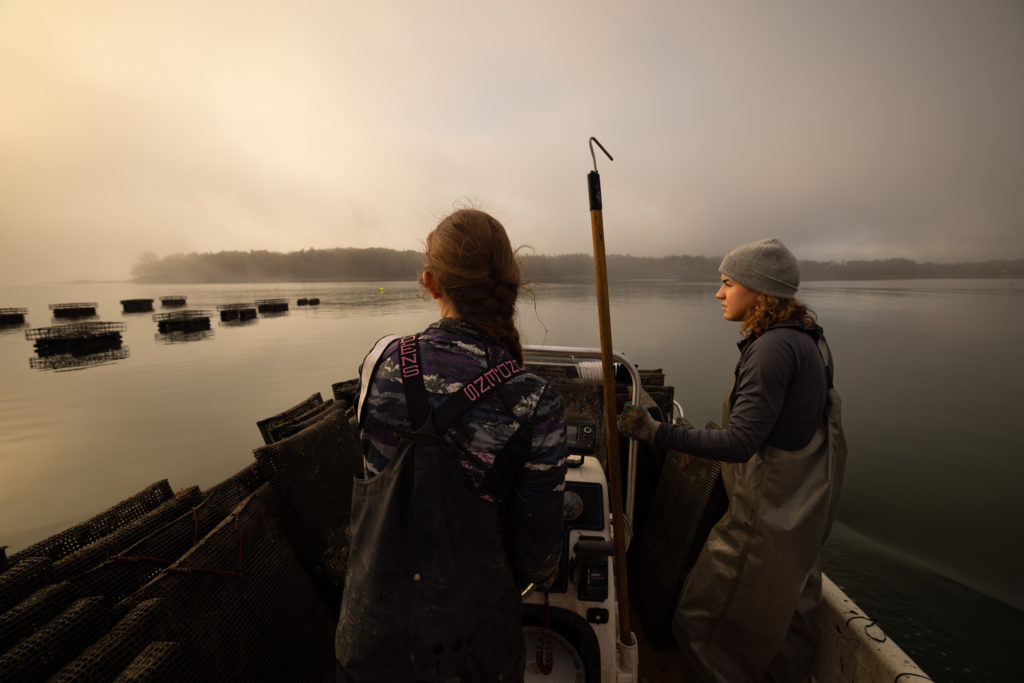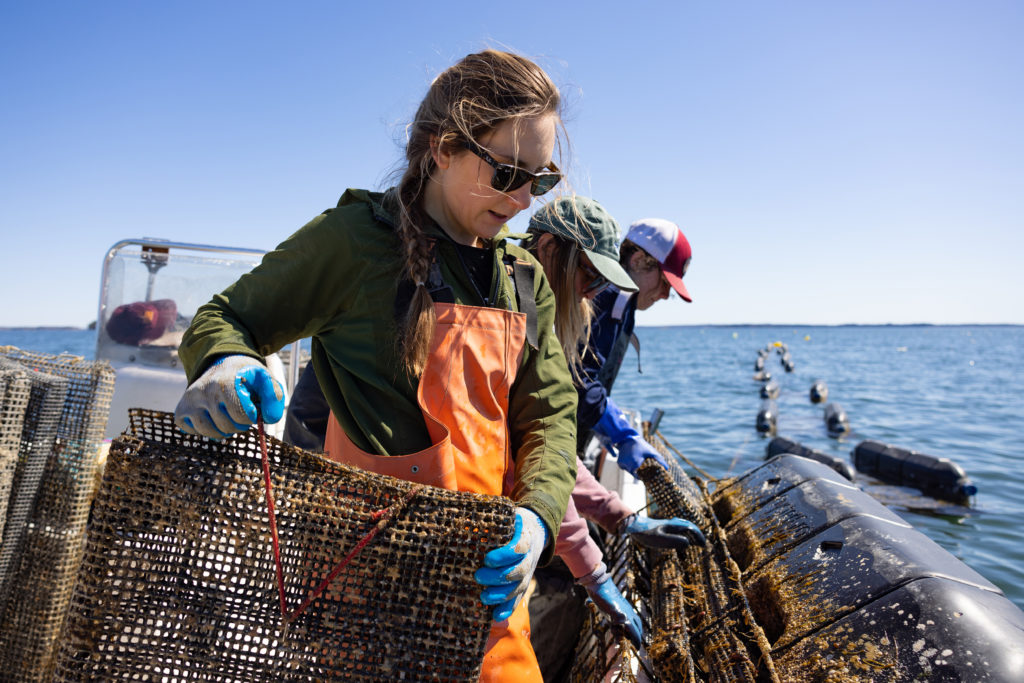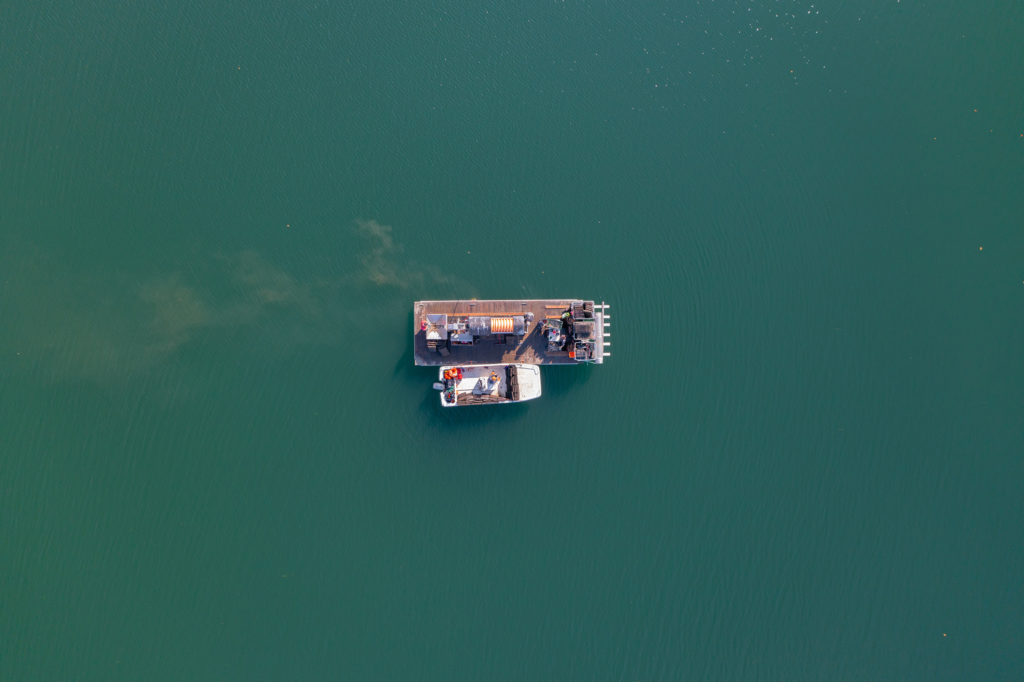Want to Help Combat Climate Change? Eat More Oysters.
Oysters and their farmers are making a big splash in Maine’s waterways—and it’s all for the good.

Want to Help Combat Climate Change? Eat More Oysters.
Oysters and their farmers are making a big splash in Maine’s waterways—and it’s all for the good.
by Anna Fiorentino
Photography by Steve De Neef
Issue: July 2022
It’s in the low 40s—freezing for April—and the rain is picking up, but Hillevi Jaegerman doesn’t seem to notice. On a fishing boat in a cove on Yarmouth’s Royal River, Jaegerman is in bright orange coveralls—no coat—whipping back one of her braids and manually cranking a big slimy cage out of the water. The winch is broken, but the oysters are ready for harvesting.
Jaegerman, co-owner and manager of Wolfe Neck Oyster Company, and her co-worker Phoebe Walsh guide the cage onto the boat and start plucking out crabs and scraping sea squirts off the oyster shells.
“We used to grow all our oysters in cages like this one that sit at the bottom, but we weren’t getting to them quick enough to keep up with demand. So we started floating some of our oysters in bags on the surface. Now we can keep up with the sea squirts too,” says Jaegerman, who just finished writing her master’s thesis for the University of New England on pathways toward resilience for the Maine oyster industry. “Plus, we’re not six feet tall. We’re definitely capable, but it’s just much easier to pull the bags off the line.”

“There’s got to be a market for sea squirts,” jokes 23-year-old Alicia Gaiero, owner of Yarmouth’s Nauti Sisters Sea Farm. Gaiero and I are standing next to each other on the Carolina skiff she calls Tidal 9, a play on the federal statute banning gender discrimination in education. Jaegerman and Gaiero have tied their two boats together, and we are drifting between their neighboring farms. It’s been too busy for water cooler talk until today.
Like gardening, in this job you must be ready for whatever Mother Nature throws your way. This year it’s sea squirts (tiny invertebrates); last year it was barnacles. But the hardest part of oyster farming has got to be planning at least two years ahead—the length of time it typically takes for oysters to grow full size—while constantly adapting to the environment and to the market. “It’s like a chess game,” says Jaegerman, who has sold her oysters to Scales, Eventide, Fore Street, Maine Oyster Company, Helm Oyster Bar, and the Shop. Turning a profit is challenging, but what many farmers lack in revenue, they make up for in quality of life.

At the start of the pandemic, when everything came to a screeching halt, Jaegerman took over management of both Wolfe Neck Oyster and its sister farm, Basket Island Oyster Company, after two of her male coworkers became stay-at-home dads. She is among a growing number of young Mainers turning to oyster farming not only to make a living but also as a way to help the environment.
Over the past decade, Maine has been nationally recognized for its plump, premium oysters growing in some of the country’s coldest waterways. The number of aquaculture licenses jumped from 44 in 2007 to 769 in 2020. Between 2018 and 2021 the number of individual shellfish leases (mostly at oyster farms) increased by 29 percent, to 140. And of Maine’s 158 oyster farms, 23 are now female-owned. That’s 15 percent—not bad for a traditionally male-dominated industry.
“We have certainly seen more farmers come online in recent years. Compared to other species, oysters are very accessible,” says Heather Sadusky, a marine extension associate at Maine Sea Grant. It helps that oyster farming has fewer up-front costs than many marine industries, such as mussel farming. Prices have steadily increased by 2 percent each year, making farm-raised oysters the fourth most valuable seafood species in Maine, with aquaculture estimated at a value of $100 million.

Raw bars and shuck trucks are popping up all over: there is Helm Oyster Bar, SoPo Seafood, and the Shuck Wagon in the greater Portland area and, downeast and on the midcoast, the LOFT Raw Bar, the HUB Market and Oysteria, and Brother Shucker. Tourists can also snack on bivalves at about 80 stops along the Maine Oyster Trail, which the Maine Aquaculture Association relaunched last year and now runs with Maine Sea Grant. The trail, which recently won the Governor’s Award for Leadership and Growth, directs participants to a series of farm tours (including Wolfe Neck’s) and raw bars around the state to earn prizes and learn to shuck, slurp, and master briny, earthy, and buttery flavor profiles. In this growing blue economy, Governor Janet Mills recently announced the state will contribute millions of dollars to support our sea farms to create new jobs and diversify Maine’s resources. Even the state’s office of tourism is jump-ing on the oyster wagon, with a new promo video showcasing Maine as a leader in aquatourism.
“Oysters are by far the most popular species to farm in Maine aquaculture,” says Afton Vigue of the Maine Aquaculture Association. “They are less labor and capital intensive than other species such as mussels and salmon, and also fetch a higher per-unit market price.” In fact, oysters are in such high demand that farms have had to turn customers away.



This surge of young oyster farmers in Maine has been greeted by emerging evidence suggesting that sustain-ably farmed oysters, grown from “seed” exclusively for our consumption, help to restore devastated wild oyster populations in one of the world’s most endangered habitats. While people have been eating wild oysters for over 165,000 years, and Native Americans once managed oyster reefs, which prevent erosion, many wild populations experienced a near total collapse in 2012 from overfishing, disease caused by pollution, and climate change. And they still haven’t recovered.
Thankfully, farming caged oysters for restaurants is one of the only fishing practices that actually helps restore wild populations. The cages and the shells themselves provide habitat for and encourage the regrowth of other species of young sea creatures, like the sea squirts. They’re also home to oyster larvae, which can escape and seed wild populations on their own. Unlike most seafood, farmed oysters not only feed and “house” hundreds of species of fish, they also help to clean waterways, filtering 50 gallons of water a day from pollutants like excess nitrogen from agricultural runoff. That clears the way for more sunlight to hit the ocean floor and grow eelgrass, which provides a habitat for many species. So, by snacking on oysters at restaurants, you’re helping to enrich our waterways. As a result, scientists around the world have started encouraging oyster farming—which uses almost no greenhouse gas emissions, water, feed, fertilizer, or food—to grow back species that have begun to drop off and restore biodiversity in our oceans.

In Maine, the industry might not exist without pioneers like Barbara Scully, who 25 years ago established the gold standard of cultured oysters in Maine. She was one of the first to successfully grow oysters here, at Glidden Point, which once moved $10 million in oysters a year across the U.S. and Canada, making her instrumental in Maine’s oyster resurgence. It was Scully who recognized the Damariscotta River as a nutrient-rich hotbed for growing oysters.
“There are many newcomers to the oyster aquaculture industry—so many new operations, leases, and people that it’s hard to keep up with,” says Scully, who mentors new oyster farmers like Gaiero, one of six women to launch oyster farms in Maine over the past three years. Many of them now occupy southern Maine’s brackish bays, rivers, and estuaries.
The women untie the boats, and we make a final stop at Gaiero’s floating cages, one of which has sunk to the bottom—she’ll have to dive down and drag it up later. The good news is, her oysters have doubled in size. And, with rain slapping my face as we ride Tidal 9 back to the dock, Gaiero tells me her tips for making it on a new farm. (Oyster farms aren’t the kind of fishing operations where secrets are kept.) First, she says, take your friend up on her offer to come out and help—and take a hint when she “casually leaves a lemon and a knife at the helm.” Next, use your resources to build a few depend-able side hustles.

Gaiero’s supplemental income comes from a consulting gig she calls East Coast Aquaculture, where she helps small-scale shellfish and kelp farms navigate the thorny process of obtaining limited farm licenses and land leases, which are backlogged from COVID. Her clients have included the female-owned Islesboro Oyster Company and Cumber-land’s Grace Pointe Oysters, and the new National Science Foundation–funded marine institute at Belfast Area High School, her alma mater. She’s also using her degree in environmental policy planning as well as geographic information systems to create and sell maps to farmers and operators. And she’s just 23 years old, with no family history on the waterfront. “Aquaculture allows entry from those who haven’t grown up on the working waterfront but are just as capable of success,” she says.
If she could, Gaiero would be out here every day clinging to her oysters like the sea squirts. “I’m not in the ideal position to acquire financing without any money coming in, but I’ve been really fortunate on a small scale to have significantly more demand than product,” says Gaiero, who has sold her oysters at Highroller Lobster Company, SoPo Seafood, Maine Oyster, J’s Oyster, and Helm Oyster Bar. Like many oyster farmers, eventually she hopes to scale up and tap into the out-of-state market.

Rather than competing, this new guard of farmers is banding together to grow the Maine oyster brand, making a splash locally at shucking events and fundraisers and changing the seascape of Maine’s working—and now floating— waterfront. At Portland’s breweries and private events, you might stumble upon a new female-owned network-ing hub and mobile raw bar, Lady Shuckers, run by Libby Davis and Jacqueline Clark, a former litigation attorney who quit her job to move to Maine and help promote the oyster industry with her blog, The Briny Babe. “There are so many female farmers, and so many to look up to, like Joanna Fogg [co-owner of Bar Harbor Oyster Company] or Amanda Moeser [owner of Lanes Island Oysters],” says Gaiero. Now, even Linda Greenlaw, the best-selling maritime author once dubbed the only female swordfishing boat captain on the East Coast, just started an oyster farm in Surry.
But really, there’s no better reminder of what oyster farm-ing is all about than when I hear Jaegerman tell me that her co-owner, the founder of Wolfe Neck Oyster and Basket Island Oyster, Mark Green, is also a professor of chemical oceanography and environmental science at St. Joseph’s College. Except maybe when you consider the oysters them-selves, sitting there, selflessly pumping nutrients back into the ocean, cleaning our waterways, regrowing their own species and replenishing others, asking only that we do the same in return for our oceans. “The emphasis deserves to be placed on all the great farmers working hard to be stewards of the marine ecosystem,” says Jaegerman, “and to grow the greatest oysters out there, regardless of gender.”

Read More:
- Branching Out

- 48 Hours in Cape Elizabeth, South Portland + Scarborough

- 4 Unique Winter Weekends

- Where to Cross-Country Ski This Winter

- Brunswick in 48 Hours


